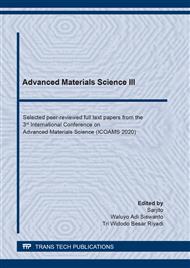[1]
Agriculture, U.S.D.o. Rice Outlook Report October 2019. 2019 [cited 2020 December 8, 2020].
Google Scholar
[2]
Statistik, B.P. Luas panen dan produksi padi pada tahun 2020 mengalami kenaikan dibandingkan tahun 2019 masing-masing sebesar 1,02 dan 1,02 persen. 2020 [cited 2020 December 8, 2020].
DOI: 10.31219/osf.io/yftg7
Google Scholar
[3]
Saunders, R.M., Rice bran: Composition and potential food uses. Food Reviews International, 1985. 1(3): pp.465-495.
DOI: 10.1080/87559128509540780
Google Scholar
[4]
Cook, D.J., R.P. Pama, and B.K. Paul, Rice Husk Ash-Lime-Cement Mixes for Use in Masonry Units. Building and Environment, 1977. 12: pp.281-288.
DOI: 10.1016/0360-1323(77)90031-2
Google Scholar
[5]
James, J. and M.S. Rao, Reaction product of lime and silica from rice husk ash. Cement and Concrete Research, 1986. 16: pp.67-73.
DOI: 10.1016/0008-8846(86)90069-4
Google Scholar
[6]
Yalçin, N. and V. Sevinç, Studies on silica obtained from rice husk. Ceramics International, 2001. 27(2): pp.219-224.
DOI: 10.1016/s0272-8842(00)00068-7
Google Scholar
[7]
Hani, A.S., et al., The influence of micronised biomass silica in compressive strength and water permeability of concrete. MASAUM Journal of Basic and Applied Sciences, 2009. 1(3): pp.493-496.
Google Scholar
[8]
Hassan, M.A. and A.H.M. Mustapha, Effect of rice husk ash on cement stabilized laterite. Leonardo Electronic Journal of Practises and Technologies, 2007(11): pp.47-58.
Google Scholar
[9]
Jha, J.N. and K.S. Gill, Effect of rice husk ash on lime stabilization. Journal of the Institution of Engineers (India), 2006. 87: pp.33-39.
Google Scholar
[10]
Laksmono, J.A. Pemanfaatan abu sekam padi sebagai bahan baku silika. in Seminar Tantangan Penelitian Kimia. 2002. Jakarta: Lembaga Ilmu Pengetahuan Indonesia (LIPI).
DOI: 10.31227/osf.io/9eam2
Google Scholar
[11]
Al-Khalaf, M.N. and H.A. Yousif, Use of rice husk ash in concrete. International Journal of Cement Composites and Lightweight Concrete, 1984. 6(4): pp.241-248.
DOI: 10.1016/0262-5075(84)90019-8
Google Scholar
[12]
Sensale, G.R.d., Strength development of concrete with rice-husk ash. Cement and Concrete Composites, 2006. 28(2): pp.158-160.
DOI: 10.1016/j.cemconcomp.2005.09.005
Google Scholar
[13]
Jauberthie, R., et al., Origin of the pozzolanic effect of rice husks. Construction and Building Materials, 2000. 14(8): pp.419-423.
DOI: 10.1016/s0950-0618(00)00045-3
Google Scholar
[14]
Ismail, M.S. and A.M. Waliuddin, Effect of rice husk ash on high strength concrete. Construction and Building Materials, 1996. 10(7): pp.521-526.
DOI: 10.1016/0950-0618(96)00010-4
Google Scholar
[15]
Mehta, P.K., Siliceous ashes and hydraulic cements prepared therefrom. July 1973: Belgium.
Google Scholar
[16]
Odler, I., Special Inorganic Cement. 2000, London: E & FN Spon, Taylor and Francis Group.
Google Scholar
[17]
Ramezanianpour, A.A., M.M. Khani, and G. Ahmadibeni, The effect of rice husk ash on mechanical properties and durability of sustainable concrete. International Journal of Civil Engineering, 2009. 7(2): pp.83-91.
Google Scholar
[18]
Chareerat, T., et al. Composition and Microstructure of Fly Ash Geopolymer Containing Rice Husk Ash. in Technology and Innovation for Sustainable Development Conference. 2008. Thailand.
Google Scholar
[19]
Nair, D.G., et al., A structural investigation to the pozzolanic activity of rice husk ashes. Cement and Concrete Research, 2008. 38: pp.861-869.
DOI: 10.1016/j.cemconres.2007.10.004
Google Scholar
[20]
Walker, P. and T. Stace, Properties of some cement stabilised compressed earth blocks and mortars. Materials and Structures/Mat4riaux et Constructions, 1996. 30(November 1997): pp.545-551.
DOI: 10.1007/bf02486398
Google Scholar
[21]
Guettala, A., A. Abibsi, and H. Houari, Durability study of stabilized earth concrete under both laboratory and climatic conditions exposure. Construction and Building Materials, 2006. 20(3): pp.119-127.
DOI: 10.1016/j.conbuildmat.2005.02.001
Google Scholar
[22]
Walker, P., Strength, durability and shrinkage characteristics of cement stabilised soil blocks. Cement and Concrete Composites, 1995. 17(4): pp.301-310.
DOI: 10.1016/0958-9465(95)00019-9
Google Scholar
[23]
Walker, P., Strength and Erosion Characteristics of Earth Blocks and Earth Block Masonry. Journal of Materials in Civil Engineering, 2004. 16(5): pp.497-506.
DOI: 10.1061/(asce)0899-1561(2004)16:5(497)
Google Scholar
[24]
Jayasinghe, C. and R.S. Mallawaarachchi, Flexural strength of compressed stabilized earth masonry materials. Materials & Design, 2009. 30(9): pp.3859-3868.
DOI: 10.1016/j.matdes.2009.01.029
Google Scholar
[25]
Walker, P., Bond Characteristic of Earth Block Masonry Journal of Materials in Civil Engineering, 1999. 11(3): pp.249-256.
Google Scholar
[26]
Oti, J.E., J.M. Kinuthia, and J. Bai, Engineering properties of unfired clay masonry bricks. Engineering Geology, 2009. 107(3-4): pp.130-139.
DOI: 10.1016/j.enggeo.2009.05.002
Google Scholar
[27]
Oti, J.E., J.M. Kinuthia, and J. Bai, Compressive strength and microstructural analysis of unfired clay masonry bricks. Engineering Geology, 2009. 109(3-4): pp.230-240.
DOI: 10.1016/j.enggeo.2009.08.010
Google Scholar
[28]
Oti, J.E., J.M. Kinuthia, and J. Bai, Design thermal values for unfired clay bricks. Materials & Design, 2009. 31(1): pp.104-112.
DOI: 10.1016/j.matdes.2009.07.011
Google Scholar
[29]
Bahar, R., M. Benazzoug, and S. Kenai, Performance of compacted cement-stabilised soil. Cement and Concrete Composites, 2004. 26(7): pp.811-820.
DOI: 10.1016/j.cemconcomp.2004.01.003
Google Scholar
[30]
Cordeiro, G.C., et al., Influence of particle size and specific surface area on the pozzolanic activity of residual rice husk ash. Cement and Concrete Composites, 2011. 33(5): pp.529-534.
DOI: 10.1016/j.cemconcomp.2011.02.005
Google Scholar
[31]
Park, B.-D., et al., Characterization of anatomical features and silica distribution in rice husk using microscopic and micro-analytical techniques. Biomass and Bioenergy, 2003. 25(3): pp.319-327.
DOI: 10.1016/s0961-9534(03)00014-x
Google Scholar
[32]
Hadipramana, J., et al. Pozzolanic Characterization Of Waste Rice Husk Ash (RHA) From Muar, Malaysia. in International Engineering Research and Innovation Symposium (IRIS). 2016. Melaka, Malaysia.
DOI: 10.1088/1757-899x/160/1/012066
Google Scholar


